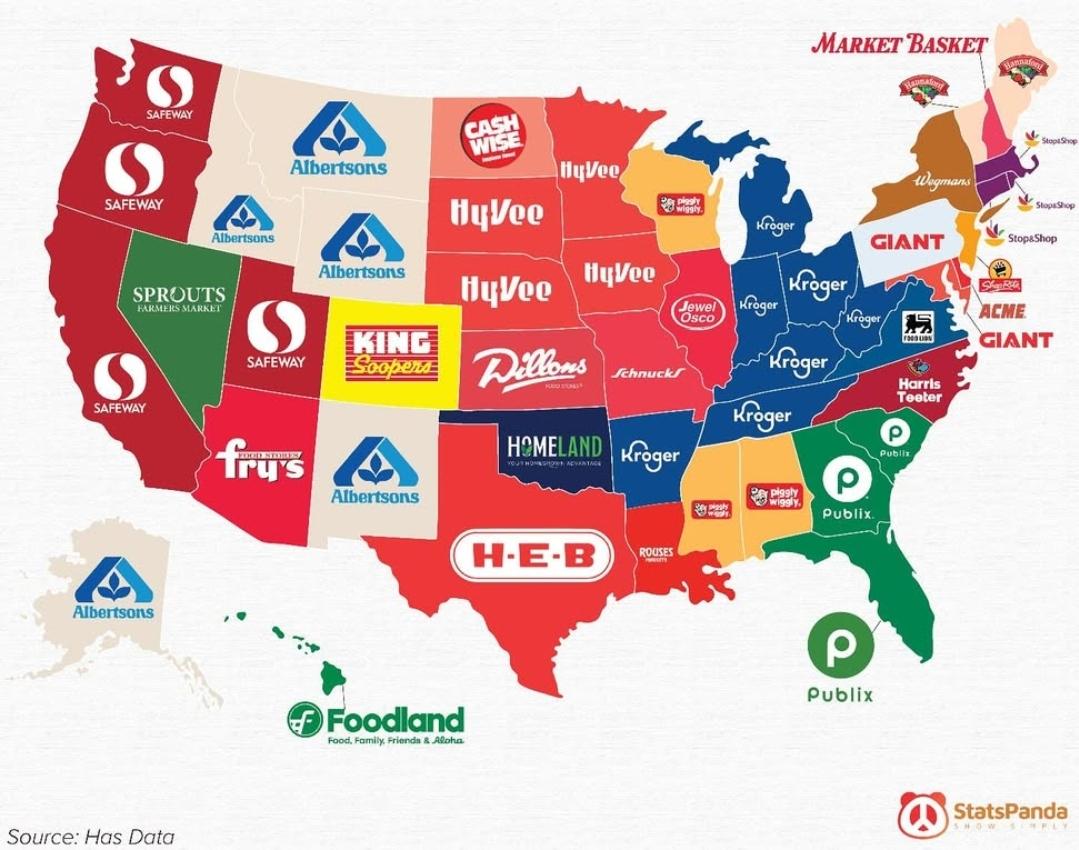Most Popular Grocery Store by State Map


David Chen
Data Visualization Specialist
David Chen is an expert in transforming complex geographic datasets into compelling visual narratives. He combines his background in computer science ...
Geographic Analysis
What This Map Shows
The "Most Popular Grocery Store by State" map provides a fascinating glimpse into American consumer habits by illustrating which grocery store chains dominate in each state. This visualization is not just a reflection of preferences; it reveals regional tastes, economic considerations, and even cultural influences that shape where Americans choose to shop for their groceries. From coast to coast, the map highlights the national giants like Walmart and Kroger, but also sheds light on regional favorites and niche players that cater to local communities.
Deep Dive into Grocery Store Preferences
When we delve into grocery store preferences, we uncover a complex interplay of supply chains, customer loyalty, and local economies. Grocery shopping is one of the most routine activities in American life, impacting not only individual households but also the broader economy. In recent years, grocery store preferences have shifted significantly due to various factors including the rise of online shopping, changes in consumer behavior, and the increasing awareness of health and sustainability.
Interestingly, while large chains like Walmart and Costco dominate many states, regional players like Publix in the Southeast or H-E-B in Texas showcase how local tastes can influence shopping habits. These stores often provide products that resonate with local cultures, such as fresh seafood in coastal areas or organic produce in more health-conscious communities.
Moreover, the popularity of grocery stores often correlates with demographic factors such as income levels, population density, and urban versus rural settings. For instance, urban areas may see a higher concentration of specialty stores and markets that cater to diverse populations, while rural regions may rely heavily on larger chains that offer a broader selection at lower prices.
The impact of e-commerce cannot be overlooked either; grocery delivery services and online shopping options have transformed how many people approach their food purchasing. This shift has created a new category of grocery shopping preferences that the map might not fully capture, but it’s critical to consider as we think about the future of grocery retailing.
Regional Analysis
Examining the map closely, we can see distinct regional patterns in grocery store preferences. In the Northeast, for example, chains like Stop & Shop and Wegmans dominate the landscape. Wegmans, known for its high-quality products and customer experience, has cultivated a loyal following that is often attributed to its emphasis on local sourcing and community engagement.
In contrast, the Southwest shows a strong preference for stores like Albertsons and Safeway. What’s intriguing here is how these grocery chains have adapted to cater to the diverse tastes of the populations in states like Arizona and New Mexico, where there’s a significant demand for both traditional and international products.
Meanwhile, in the Midwest, chains like Meijer and Hy-Vee stand out. Both retailers focus on customer service and community ties, often offering unique local products that resonate with their customer base. It’s noteworthy how these stores have managed to cultivate a sense of loyalty, competing effectively against larger national players.
Interestingly, the map also highlights the dominance of Costco in many states, especially in the West and Pacific regions. This preference showcases a trend towards bulk buying and value shopping that has gained traction among families and budget-conscious consumers.
Significance and Impact
Understanding grocery store preferences is more than just a matter of consumer choice; it has significant implications for local economies, employment, and even public health. For example, the presence of grocery stores in underserved areas can influence food accessibility and nutritional choices, affecting the health of entire communities.
As we move forward, we should consider how shifts in consumer behavior, such as the move towards online shopping and local sourcing, will continue to reshape the grocery landscape. The COVID-19 pandemic has accelerated some of these trends, with many consumers becoming more aware of food sourcing and sustainability.
Moreover, as food prices fluctuate and supply chains adapt to new challenges, grocery store preferences will likely continue to evolve, reflecting broader economic and social trends. This map serves as a snapshot of where we are today, but it also invites us to ponder where we might go in the future.
In conclusion, the study of grocery store popularity by state not only uncovers consumer habits but also opens a dialogue about regional identities, economic strategies, and the ongoing evolution of retail in America. As we shop for our groceries, we are also participating in a much larger story about culture, economy, and community.
Visualization Details
- Published
- October 15, 2025
- Views
- 30
Comments
Loading comments...